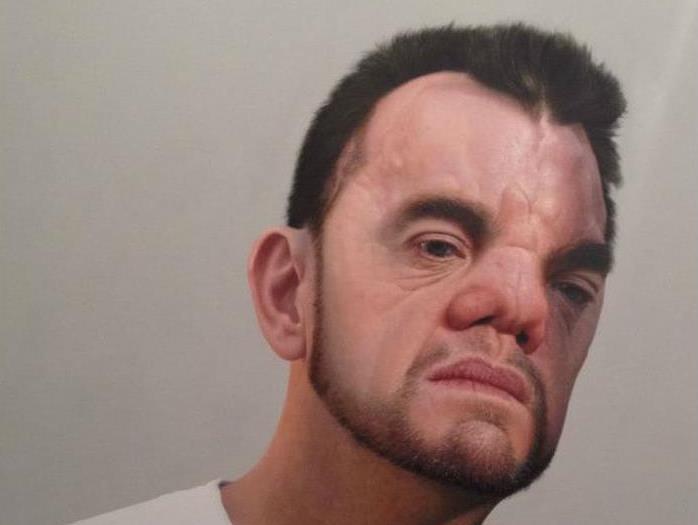Four years selected as an Archie finalist this year Nick Stathopoulos was in the Salon for his portrait of Robert Hoge (Detail); courtesy the artist.
Some times known as ‘the best of the rest’, the Salon des Refusé is SH Ervin Gallery’s cut of the crop of annual entrants to Australia’s most famous prizes for portraiture and landscape.
After the 11 Trustees of the AGNSW selected this year’s 115 finalists for the Archibald, Wynne and Sulman prizes, they passed on “the rejects” to a second group of selectors in a separate room to choose the Salon des Refusé.
And while we Salon des Refusé selectors were hardly a group of beret-wearing dissidents, we are aware of the value of the Salon in driving debate and a democratisation of the gallery experience.
We have all been tutored in the Salon’s origins – the breakaway exhibition of the 1860s Parisian Academy endorsed by Napoleon. The Australian version came about in 1992, and its popularity continues to grow.
It garners the attention of many, trying to figure out why these works were rejected. But the exhibition’s main criteria is that, ‘it is a good painting first, and that it is engaging, innovative, irreverent or all of the above’, said Director of SH Ervin and perennial selector Jane Watters.
I joined Watters this year in the task along with fellow writer Andrew Frost, and yes, we did look at the 1,972 artworks that remained after the gallery’s Trustees had taken their pick.
It takes two days, perched in the gallery surrounded by stacks of paintings as each entrant is carried by for consideration. One of the greatest catch-cry criticisms is that ‘they don’t look at them all’. I can assure you “they” do! I will admit, the Trustees deliberated longer than we did – perhaps that is the difference between satisfying the personal tick-box of 11 selectors rather than three. The selection process is taken seriously by all.
Watters said: ‘The main challenges for the exhibition are that unlike a curated exhibition where a curator has time to consider the artists and works displayed, with the Salon it is entirely dependent on the entries and also on the selectors’ judgement of the paintings as they are viewed.’
You are also working with what is left. It is not the extraordinary velocity or volume of the selection process, which one would expect to be its most daunting aspect, rather it is the sheer volume of “bad painting” and then the reaffirmation that indeed we have some great artists out there, and not always the usual suspects. The surprises erase cynicism, and it’s refreshing. You have to trust your eye and respect the dynamic of the selecting team. Is that taste, experience, or is that selection?
How did we fare? You will have to be the judge of that.
For Watters she felt this year was one of the gallery’s better Salons; and I would add particularly the Wynne crop of works, which I might even suggest trumps the AGNSW’s field which are more bravado and less heart.
So the highlights? Watters has set the tone with visitors walking into the Wynne “rejects”, hanging works by Sophie Cape and Joanna Logue, both stunning ethereal yet gutsy works.
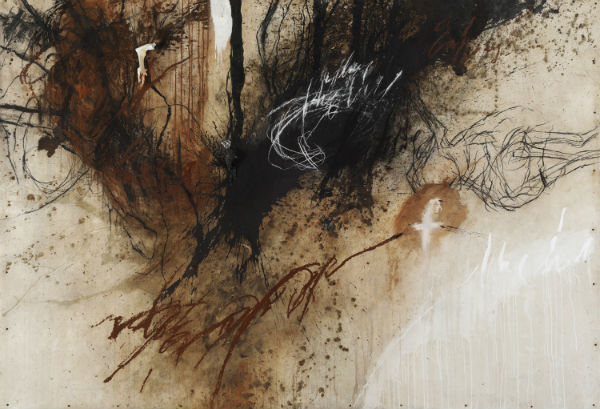
Sophie Cape’s The earth whirls toward a creation unknown; Courtesy the artist
To one side, Watters has corralled a group paintings that explore the urban landscape in contrast to the more traditional, or typical entrant, with standout works by Craig Handley, with a still life of curb-side detritus, to Penelope Metcalf’s Red centre (plein air project), the ubiquitous redbrick apartment block, the first work we viewed which remained a strong “yes” after viewing near 2,000 works.
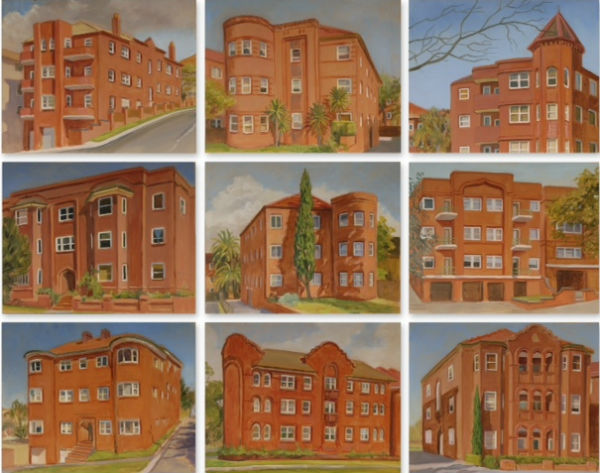
Penelope Metcalf’s Red centre (plein air project); courtesy the artist
Other Wynne works that deserve a nod are a stunning painting by Indigenous artist Margaret Loy Pula of her Anatye (Bush Potato); Christopher McVinish nostalgic painting of the public pool we all grew up with, Closed until further notice; Amanda Penrose Hart’s painterly zip or slice through a landscape; to strong paintings by Mostyn Bramley-Moore, Peter Sharp and a very pink waterhole by Craig Waddell – the range is clearly an enjoyable stroll through the genre.
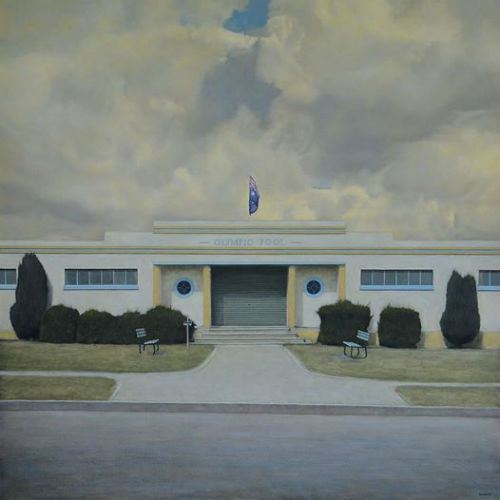
Christopher McVinish’s Closed until further notice; courtesy the artist
The Salon’s Archie selection is the more talked-about, maybe it has a little to do with our lust for selfies and the cult of the celebrity? One such talking point has been two-time Archibald finalist and past winner of the Sulman Prize, Michael Lindeman’s portrait of the erudite Andrew Denton, Note to Self, a steroid-size Post-it note that plays off the “vacuousness” of much communication.
Emblazoned with the words “Slave to the algorithm”, Lindeman’s pun on Grace Jones’ famous song was inspired by Denton’s lack of engagement with the world of social media.
‘We aim to present contemporary portraiture therefore likeness is not the foremost consideration although good realist paintings are appreciated by the selectors,’ said Watters. ‘I look for the work to tell me something about the sitter – I prefer works that explore the psychological aspects of a person or incorporate references to that person’s personality or life to give the work meaning.’
And, while some might question the technical prowess of Darren McDonald’s painting of artists Brent Harris & Andrew Browne, or Clara Adolph’s heavy impasto portrait of artist Alan Jones (artist portraits were a big theme this year), or perhaps even Peter Gardiner’s fiery rendition of Ron Ramsey – these are portraits with connection and an individual voice.
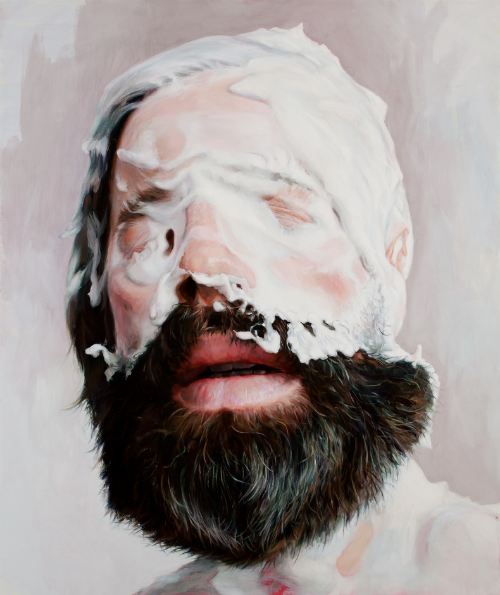
Celeste Chandler’s I feel for you 3 (Andrew); courtesy the artist.
Other portraits that made our cut were: four times Archibald finalist Nick Stathopoulos’ photo-realist portrait of writer Robert Hoge (pictured top); Celeste Chandler’s obscured portrait of Andrew Dewhurst, I feel for you 3; Robert Hannaford’s portrait of broadcaster Phillip Adams; a very purple Russell Morris, The Real Thing’s lead singer painted by Raelene Sharp; and paintings by perennial favourites Tom Carment, David Fairbairn, Jasper Knight, all in this year’s Salon.
A surprise rejection that fell our way was Nicholas Harding’s painting was Playing for Godot (Mullins, Weaving, Roxburgh and Quast), painted from Harding’s much talked about residency with the Sydney Theatre Company.
One consideration that most would not think of, either when entering a work or understanding why it might have been rejected, is the difficult to hang it. One such painting passed by the Trustees this year was Leslie Rice’s huge self portrait painted on black velvet in an elaborate black frame, its glass surface highly reflective. Its weight, scale and impenetrability was a challenge. This picture below is probably the best look you will get at it!
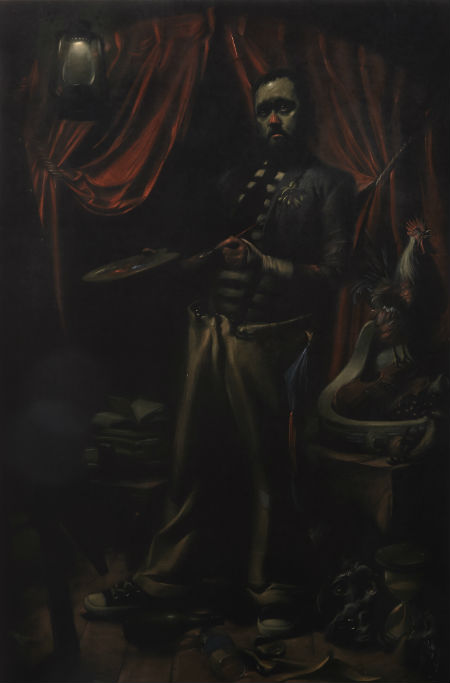
Leslie Rice’s daunting velvet painting, Self portrait (painted by the artist at the halfway point of the term of his natural life); courtesy the artist.
For other artists, it is the debate that follows them. A regular on the Archie circuit, Jenny Sages made the Salon cut again, although her portrait of Dr Sarah Engledow lacks the chutzpah of last year’s entry that caused all the “noise” when not selected for the 2013 Archie.
And then you have the anomalies – where do they fit? Julie Donnelly’s installation of crystal towers, The pinnacles, was selected from a frighteningly poor grouping of sculptural entrants this year. It certainly trumps the AGNSW’s selected of Stephen Pong’s Broken Well. Perhaps boxes and agendas got in the way on that one?
Then you are also handed, what I consider, “no brainers”. One of the must includes for our selection panel was the pairing, bridging the Wynne and Archibald Prizes, was Stephen Hart’s delighted sculpture of himself, A sculptor, full of sincerity and contemplation; with Stephen Nothling’s painting of the same portrait.
Selecting the Archibald, Wynne, Sulman and Salon is a roller-coaster ride endured for several hours, with highs and lows, moments of exhilaration and belly-dropping despair, but mostly it instills a heartening faith in the system – all can enter and all have the opportunity to be hung, and their work seen on an even playing field.
But unlike that “other” gallery’s exhibition of finalists, the Salon des Refusé is not driven by selecting a winner.
However, just like the main event at the AGNSW, you too can have your pick at the Salon. Visitors to the exhibition also have the opportunity to vote in the Holding Redlich People’s Choice Award for their favourite work.
For a full list of selected artists for the 2014 Salon des Refusé or better still take your self off to the exhibition and cast your opinion!
Salon des Refusé
19 JULY – 14 SEPTEMBER
SH Ervin Gallery
Observatory Hill, The Rocks, Sydney
